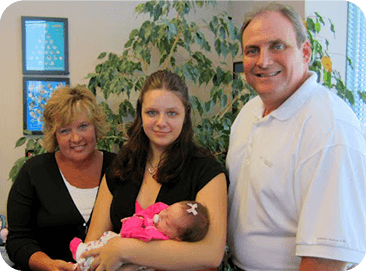 Through most of history, women who placed their children for adoption received little to no information about where their child went, who their adoptive parents were, or whether the child was safe and happy. Adopted children often grew up wondering about their origins, with adoptive parents who were unable to answer their questions.
Through most of history, women who placed their children for adoption received little to no information about where their child went, who their adoptive parents were, or whether the child was safe and happy. Adopted children often grew up wondering about their origins, with adoptive parents who were unable to answer their questions.
Fortunately, today’s adoptions look much different.
With open in North Carolina, birth mothers, adoptive families and their children are able to remain an important part of each other’s lives, receiving pictures and letter updates, exchanging emails and phone calls, and even visiting in person.
In this article, learn more about open adoption with A Child’s Hope and the many benefits it offers today’s children, birth parents and adoptive families.What Does Open Adoption Mean?
In adoption, “openness” refers to the amount of contact shared between adoptive parents and prospective birth parents during and after the adoption. An estimated 95 percent of today’s adoptions involve some level of openness.
Because every adoption relationship has its own unique degree of openness, there is no single open adoption definition. However, most in the adoption community define open adoption in one of two ways:
While adoptions are becoming increasingly open, most of today’s adoptions fall into the semi-open category. Whatever type of post-adoption relationship you are interested in having, your adoption counselor can help you find a match who wants to have the same relationship with you.
With A Child’s Hope, the amount and frequency of contact shared between the birth parents and adoptive family is determined by mutual consent. Some birth parents and adoptive families decide they want to receive photographs and letters over time, while a very small percentage choose a closed adoption, discontinuing contact after delivery.
Birth parents and adoptive families who choose open adoption will sign a release of identifying information, agreeing to direct, open communication without the agency’s involvement. From there, it is up to these families to coordinate contact during and after the adoption process, whether that includes phone calls, text messages, video chats, or face-to-face visits.
Those who choose semi-open adoption will meet each other during the adoption process on a first-name basis and communicate through the agency following placement. This communication often includes picture and letter updates, and may even include in-person visits with an adoption counselor present.
It is up to each birth parent and adoptive family to determine what type of adoption relationship they are most comfortable having. As you begin the adoption process with A Child’s Hope, you will learn more about open adoption and post-placement contact, so you can decide which option is right for your family.
There are many open adoption facts pointing to the benefits of openness in adoption, as well as heartwarming open adoption stories that demonstrate just how beneficial these relationships can be. A Child’s Hope encourages every adoptive family and prospective birth mother to consider open or semi-open adoption for the following reasons:
Like any relationship, adoption relationships often grow and evolve over time. A Child’s Hope is always available to help you navigate and maintain your open or semi-open adoption relationship through our contact mediation, counseling and support services.
To learn more about semi-open and open adoption with A Child’s Hope, contact our agency today. Our friendly adoption hotline operator can provide additional information with no obligation to proceed with an adoption plan.
Speak with one of our adoption counselors.
Call or text the Pregnancy Hotline 24/7
Get guidance on opportunities & next steps.
Our office is open in Raleigh, NC.
© 2025 A Child's Hope. All Rights Reserved.
Please select the first day of your last period
Your last period date: